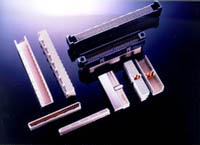 Photo Courtesy of AMP Incorporated
Photo Courtesy of AMP IncorporatedThe copper industry defines temper as "the condition produced in a metal by mechanical or thermal treatment and having characteristic structure and mechanical properties." This is a broad definition since in any copper alloy, metallurgical structure is the major determining factor of resistance to deformation during fabrication and use.
The structure of a cast product reflects metal temperature at the time of pouring, cooling rate, and the method of containment during solidification. The wrought structure of hot-worked products reflect the hot-working temperature and the amount of mechanical work imparted. The grain structure of cold-worked products will reflect the original structure (cast or wrought) before cold working and the strain imparted by the cold work.
When used to describe a copper or copper alloy product, the temper name or designation defines a fundamental and characteristic state. Standard tempers have been established to describe a number of such states. The three basic temper categories for single phase copper and copper alloys strip, sheet and plate are hot-rolled, cold rolled and annealed. Hot rolled temper is generally only applicable to plate and is essentially the same as an annealed material having similar grain structure. The annealed and cold rolled tempers are more applicable to strip products which are the focus of this publication.
